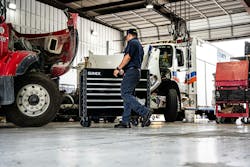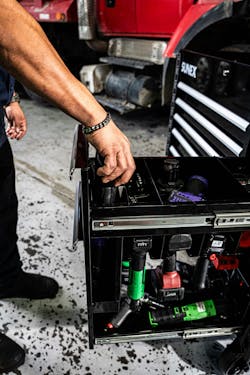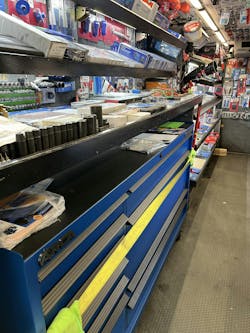A technician without a good set of storage tools is fated to be disorganized. Without the proper means to keep their things safe and stowed away, they lose out not only on the time they spend looking for the right tools, but also the additional money they could be making by taking on more repairs. If they’ve got tools, they’ll need a place to store them. That’s where distributors like Rich Rossi come in.
Rossi, a Cornwell distributor, has been in the business of mobile tool dealing for a little over three years, but before that he was an automotive technician for 41 years. Located in Northeast Pennsylvania, Rossi stops at dealerships, independent shops, body shops, heavy duty shops and more. What all these shops have in common is their need for tool storage and organization. Whether its a toolbox or cart, drawer inserts or magnetic trays, Rossi has his clients covered.
The importance of storage
The benefits of tool storage are so vast that we could sit here for hours discussing the need for organization in a repair shop, but I’ll spare you the page turning. Along with Rossi, we sat down with SUNEX Tools, Mechanic’s Time Savers, and EZRED, and narrowed down four key benefits to having tool storage and organization in the automotive shop. Lean on these when it comes to your selling approach.
Efficiency
When a technician keeps their tools and equipment organized they cut back on the time it would otherwise take searching for a wrench or whatever it is they might need. They’re moving faster and getting more work done at an efficient pace which in turn opens up opportunities to make more money.
“Knowing exactly where each tool is can save time, improving productivity,” says Josh Holley, product manager at SUNEX.
EZRED’s Jake Millman, business development manager, seconds that notion. “Techs get paid when jobs get finished. The ease of knowing where your tools are is big.”
Mechanic’s Time Savers offers clear identification markings on organizers, cutting down on the time it takes a technician to find the right size.
“We’ve been releasing tool organization with easy to resize indicators on them,” Alexis Barfoot, project and marketing manager for Mechanic’s Time Savers, says. “We sell both metric and SAE clips and they pop off so you can customize it. If a [technician] might want to have a magnetic rail with their most used sockets, they can quickly customize that and have it right there. So not only does it offer the customization, but it’s easy to see.”
Security
Tool organization can give technicians a level of security that they might not otherwise have. You wouldn’t keep your tool truck unlocked, thousands of dollars of product unattended and primed for the taking, and neither should a technician have their tools out in the open to get lost—or worse, stolen.
“It’s easy to quickly tell what’s missing. Most shops have multiple mechanics,” says Barfoot. “And if someone borrows your tool or walks off with it and puts it somewhere else, you can quickly tell if it’s missing. And then also lock it up. Some people deal with theft, so it just keeps your stuff together.”
Professionalism
It’s no secret that a well-organized workspace lends to a more professional look. In an automotive shop, where customers can expect to pay hundreds or even thousands of dollars, that level of professionalism can help them feel assured that their cars are being taken care of by someone who knows what they’re doing.
“A well-maintained tool area reflects a professional work ethic,” Holley of SUNEX explains. “Which is especially important in commercial or shared workshop settings.”
SUNEX offers a Folding Magnetic Tray that keeps fasteners, parts, tools, and more all neatly together as a technician works through a repair. Instead of having these tools strewn about they can keep them contained and tidy.
Tool longevity
If you’ve ever stepped inside a repair shop, you know that it’s probably not the first place you’d pick to leave something fragile just lying around. From oils, chemicals, and more it’s no guarantee that a tool left unattended on any given surface won’t sustain some level of damage. By keeping these tools put away when not in use, technicians can save themselves the headache of needing to buy a replacement earlier than needed.
“Properly stored tools are less likely to get lost or damaged, reducing the need to replace or repair tools,” Holley says.
EZRED offers both a Ratchet Holder and Plier Holder, both lightweight and customizable, for technicians to store these tools in a customizable way that keeps them out of the way of the harsh shop environment.
More than just a toolbox
While toolboxes, carts, and workstations tend to be the thing that comes to mind when thinking about tool storage, there’s so much more that goes into organization than just those heavy hitters.
As EZRED Vice President Frank Cacciabeve puts it, “Toolboxes and carts are just the foundation. They are the house for your tools and, like a house, it’s just a space unless you put in the organization.”
If you’re looking to up your storage offerings, try getting your hands on magnetic solutions that keep small, loose ends together and not rolling across the shop floor; modular rails and racks to keep a technician’s most-used tools within reach; and/or drawer organizers that keep things from moving around and getting banged up.
Selling the small stuff
Unlike power tools or scan tools that can be easily demonstrated, tool storage might seem like a sitting duck on your truck just waiting for the right technician who needs an extra cart or wrench organizer to come by and scoop them up. You may not realize the potential in the way that that organizational duck is placed on the truck, maybe it’s time for a bit of rearranging.
“Where we’ve seen dealers have success is actually using [the products],” EZRED’s Millman explains. “They sell wrenches and sockets, so they load it up and throw it on their truck somewhere magnetic and hit their route. When someone walks on the truck, they easily see it loaded and see the strength of the magnets.”
This approach to displaying organizational tools can also save you space, Mechanic’s Time Saver’s Barfoot notes.
“By showing the customer the tool already in the organizer, they can sell both at the same time,” she explains. “It increases sales numbers and it teaches the customer how to set up their boxes showcasing functionality and so [distributors] can have a full setup in their truck.”
You can create a showroom of sorts on the truck, with smaller organizational products being displayed in the same way they would be used in a shop, but these tools don’t have to just sit there. Rossi sometimes takes these smaller products out to his clients.
“I’ll actually take them into a shop and do a demonstration to the technicians there, that’s an easy sell right there,” Rossi says. “They see like a bowl that’s going to hold all their nuts and bolts. If they’re doing an intake job, it’s like, ‘I need that.’”
Rossi has found that once a technician sees him demonstrate the product they’ll want to try it for themselves—test out the magnets, push the weight capacity to its limits—and then the sale is essentially made.
Toolboxes and carts
When it comes to bigger stuff that can’t be easily carted into a shop the approach doesn’t need to be complicated.
“I bring the customer out to the truck and they’re able to see the toolboxes or the cart, open the drawers, see how the drawer slides and take it from there,” Rossi says. “When you bring a customer onto your truck to look at that stuff, it’s more of an easier sale than conversation-wise.”
Rossi keeps both a toolbox and a cart on his truck at all times, selling one around every two weeks.
“I go back and forth from a 79” box to an 84” box, same way with the cart,” he explains. “So I’ll stock either a five drawer or a six drawer. I sell one every two weeks, just gotta find the right customer.”
Sometimes, when selling these bigger boxes or carts, technicians need a little nudging. When it comes to finding that right customer, it’s important to ask a few starting questions. The first, what is the technician’s current setup?
“I’ll go into a shop and see what they have,” Rossi says. “And then we’ll talk a little bit about boxes. Once you start talking about the toolbox you plant that seed and now they’re coming to you about, ‘Hey, what about this? Does your box do this?’ And that’s how the conversation would come up.”
Each technician has unique circumstances and wants for their tool storage making it important to get to know your clients so that you can anticipate their needs. A client just starting out might not have the money, or the space, to buy big toolboxes so pitching them something smaller to start might be a better approach.
“A lot of the young customers are price-driven so we just talk about the features and benefits of the box and how much weight it could hold compared to the competitors,” Rossi explains.
Mechanic’s Time Savers offers different levels of all of their products for technicians who may not be able to spend a lot of money on tool storage right out the gate.
“Whether you have a technician just entering the business or a seasoned vet, we like to offer different levels of our products to meet their needs,” Barfoot says. “We have some base models and some higher level models with more features like size indicators and magnets, but they all offer the same functionality.”
Finally, you should be asking your customers where they’re facing challenges or inefficiencies in their shop? Are they losing small things like bolts or are they finding that they’re current toolboxes just aren’t cutting it when it comes to housing their many tools?
“Focus on practical features that address everyday pain points,” SUNEX’s Holley advises. “Highlight how specific storage solutions can simplify tasks, improve access, and support a cleaner, more productive workspace.”
Trends in storage
It’s becoming more and more clear that tool storage is no longer just about functionality. Technicians are becoming increasingly interested in customization—whether in color or design—and products that offer more than just a place to store their tools.
Customizing
Being able to customize their organizational setup is a big bonus for automotive technicians, something Rossi is sure to go over with his customers.
“The color packages that [Cornwell] has are a big sell,” Rossi says. “We can even wrap up toolboxes, whether it be a magnetic wrap or a vinyl wrap. We can get pretty much any type of wrap that you want.”
Power offering
Another important factor to keep in mind when talking to your technicians about toolboxes specifically is the power offering. Rossi’s customers have been increasingly interested in power drawers in their toolboxes and carts.
“Dedicated power drawer carts have seen a rise in popularity to compliment all the power tools that techs are using,” Holley says. “This allows them to charge them all in one place and keep them secured as well.”
Mobility
Mobility also continues to be a point of interest for technicians with things like soft-sided tool bags, modular plastic organizers, and other portable options. Magnetic storage products have really seen their time in the spotlight, offering technicians both customization and mobility. A magnetic parts tray can be carried around the shop without fear of things spilling out and getting lost, then be set down on whatever surface they see fit.
As the technology surrounding tool storage evolves, Rossi keeps his nose to the ground, leaning on the knowledge and direction of his district team, but most importantly his customers.
About the Author
Elli Carder
Assistant Editor | PTEN & Professional Distributor
Elli Carder is an assistant editor for Endeavor Business Media's Vehicle Repair Group. With a background in professional and creative writing, Carder helps edit for both Professional Tools and Equipment News (PTEN) and Professional Distributor magazines, as well as VehicleServicePros.com.
Don't miss Carder's next article. Sign up for PTEN or Professional Distributor's weekly newsletter.




